
The ?eld of nuclear physics is entering the 21st century in an interesting and exciting way. On the one hand, it is changing qualitatively since new experim- tal developments allow us to direct radioactive and other exotic probes to target nuclei as well as to sparko? extremely energetic nuclear collisions. In parallel, detector systems are of an impressive sophistication. It is di?cult to envisage all the discoveries that will be made in the near future. On the other hand, the app- cations of nuclear science and technology are broadening the limits in medicine, industry, art, archaeology, and the environmental sciences, etc. This implies that the public perception of our ?eld is changing, smoothly but drastically, in c- trast to former times where nuclear weapons and nuclear power plants were the dominant applications perceived by citizens. Both aspects, scienti?c dynamism and popular recognition, should lead the ?eld to an unexpected revival. One of the consequences of the former could be that many brilliant students consider nuclear physics as an excellent ?eld in which to acquire professional expertise. Therefore, one of the challenges of the international nuclear physics community is to try to make the ?eld attractive. That means simply being pedagogic and enthusiastic. Thus, as organisers of an already established summer school, our contribution was to put an emphasis in this session on pedagogy and enthusiasm.
| ISBN: | 9783540424093 |
| Publication date: | 20th November 2001 |
| Author: | JM Arias, M Lozano |
| Publisher: | Springer an imprint of Springer Berlin Heidelberg |
| Format: | Hardback |
| Pagination: | 350 pages |
| Series: | Lecture Notes in Physics |